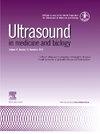Boiling Histotripsy in Ex Vivo Human Brain: Proof-of-concept
IF 2.4
3区 医学
Q2 ACOUSTICS
引用次数: 0
Abstract
Objective
Non-invasive surgical approaches, including boiling histotripsy (BH), are currently being developed for the treatment of brain disorders aiming to avoid craniotomy and exposure of intervening tissues, and, thus, minimize associated complications. This work aimed to demonstrate the feasibility of BH for mechanical fractionation of human brain tissues ex vivo under B-mode guidance, with preliminary measurements of tissue stiffness via shear wave elastography.
Methods
Young's moduli of 25 human autopsy brain samples obtained from de-identified patients of 51–91 y old (median 77 y old) were measured via shear wave elastography prior to BH sonication. Seventeen volumetric BH lesions (1–4 layers of 5 × 5 points with a 1- mm step) were produced near brain surface (n = 10), in white matter (n = 3), in thalamus (n = 2), and globus pallidus (n = 2) using 12 element 1.5 MHz sector transducer under B-mode guidance with 10 ms or 2 ms pulses delivered 10 or 15 times per sonication point with 1% duty cycle. After treatment, the lesions were evaluated grossly through bisection, histologically with hematoxylin and eosin staining, and ultrastructurally via scanning and transmission electron microscopy.
Results
Young's moduli of autopsy brain samples were lower in older patients (from 32.9 ± 6.6 kPa in 51 y olds to 10 ± 2 kPa in 91 y olds) and at higher temperature (6%–50% lower at 37°С vs 23°С), and were within the range observed clinically. All tested BH treatments performed near the brain surface (i.e., mostly in gray matter) resulted in formation of well-demarcated rectangular lesions with homogenized content and sharp boundaries, with majority of residual fragments below 100 microns. The use of shorter pulses (2 ms vs 10 ms) accelerated the treatment at least threefold, and the highest liquefaction rate was 568 mm3/min. White matter was more resistant to BH vs gray matter: at least 15 pulses of 2 ms duration were required per each sonication point, and the liquefaction rate was three times lower. The ability of BH to produce lesions in thalamus and globus pallidus was also confirmed.
Conclusion
This work presents the first demonstration of BH proof-of-concept in human brain tissues ex vivo under B-mode guidance with clinically relevant treatment rates.
体外人脑沸腾组织损伤:概念验证。
目的:目前正在开发包括沸腾组织切削术(BH)在内的非侵入性手术方法来治疗脑部疾病,目的是避免开颅手术和暴露介入组织,从而最大限度地减少相关并发症。这项研究旨在证明在 B 型引导下用 BH 对人脑组织进行体外机械分馏的可行性,并通过剪切波弹性成像对组织硬度进行初步测量:方法:在进行 BH 超声处理之前,通过剪切波弹性成像法测量了 25 份人体尸检脑样本的杨氏模量,这些样本来自 51-91 岁(中位 77 岁)的身份已被确认的患者。在 B 模式引导下,使用 12 元 1.5 MHz 扇形换能器,以 10 毫秒或 2 毫秒脉冲,在 1%占空比下,每个超声点 10 或 15 次,分别在近脑表面(10 个)、白质(3 个)、丘脑(2 个)和丘脑球(2 个)产生 17 个体积 BH 病变(1-4 层 5 × 5 点,步长 1 毫米)。治疗后,通过切片对病变进行大体评估,用苏木精和伊红染色对病变进行组织学评估,并通过扫描和透射电子显微镜对病变进行超微结构评估:年长患者尸检脑样本的杨氏模量较低(从 51 岁患者的 32.9 ± 6.6 kPa 到 91 岁患者的 10 ± 2 kPa),温度较高(37°С 与 23°С相比,杨氏模量低 6%-50%),且在临床观察范围内。所有在脑表面附近(即主要在灰质中)进行的 BH 治疗均可形成界限分明的矩形病灶,病灶内容均匀,边界清晰,大部分残留碎片低于 100 微米。使用较短的脉冲(2 毫秒对 10 毫秒)可将治疗速度提高至少三倍,最高液化率为 568 立方毫米/分钟。与灰质相比,白质对 BH 的耐受性更强:每个超声点至少需要 15 个持续时间为 2 毫秒的脉冲,液化率则低三倍。BH 在丘脑和丘脑球部产生病变的能力也得到了证实:这项研究首次展示了 BH 在 B 型引导下对人体脑组织进行体外概念验证的情况,其治疗率与临床相关。
本文章由计算机程序翻译,如有差异,请以英文原文为准。
求助全文
约1分钟内获得全文
求助全文
来源期刊
CiteScore
6.20
自引率
6.90%
发文量
325
审稿时长
70 days
期刊介绍:
Ultrasound in Medicine and Biology is the official journal of the World Federation for Ultrasound in Medicine and Biology. The journal publishes original contributions that demonstrate a novel application of an existing ultrasound technology in clinical diagnostic, interventional and therapeutic applications, new and improved clinical techniques, the physics, engineering and technology of ultrasound in medicine and biology, and the interactions between ultrasound and biological systems, including bioeffects. Papers that simply utilize standard diagnostic ultrasound as a measuring tool will be considered out of scope. Extended critical reviews of subjects of contemporary interest in the field are also published, in addition to occasional editorial articles, clinical and technical notes, book reviews, letters to the editor and a calendar of forthcoming meetings. It is the aim of the journal fully to meet the information and publication requirements of the clinicians, scientists, engineers and other professionals who constitute the biomedical ultrasonic community.

 求助内容:
求助内容: 应助结果提醒方式:
应助结果提醒方式:


